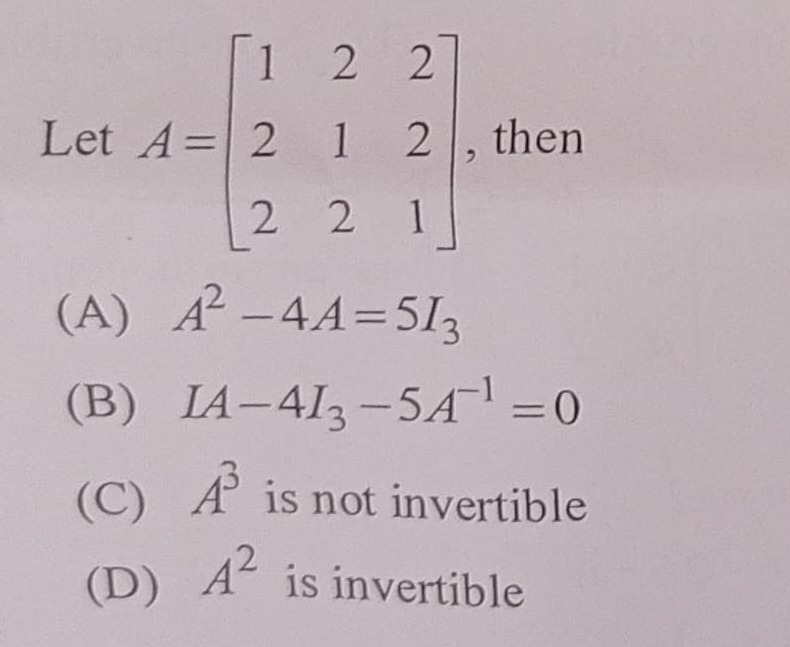Question
Question: Let $A = \begin{bmatrix} 1 & 2 & 2 \\ 2 & 1 & 2 \\ 2 & 2 & 1 \end{bmatrix}$, then...
Let A=122212221, then

A2−4A=5I3
IA−4I3−5A−1=0
A3 is not invertible
A2 is invertible
A
Solution
The given matrix is A=122212221.
First, let's calculate A2: A2=A⋅A=122212221122212221 A2=(1)(1)+(2)(2)+(2)(2)(2)(1)+(1)(2)+(2)(2)(2)(1)+(2)(2)+(1)(2)(1)(2)+(2)(1)+(2)(2)(2)(2)+(1)(1)+(2)(2)(2)(2)+(2)(1)+(1)(2)(1)(2)+(2)(2)+(2)(1)(2)(2)+(1)(2)+(2)(1)(2)(2)+(2)(2)+(1)(1) A2=1+4+42+2+42+4+22+2+44+1+44+2+22+4+24+2+24+4+1=988898889
Now let's evaluate each option:
(A) A2−4A=5I3 Calculate 4A: 4A=4122212221=488848884 Now, calculate A2−4A: A2−4A=988898889−488848884=9−48−88−88−89−48−88−88−89−4=500050005 This matrix is equal to 5I3=5100010001=500050005. So, A2−4A=5I3 is true. Option (A) is correct.
(B) IA−4I3−5A−1=0 First, calculate the determinant of A to check if A−1 exists. det(A)=122212221 det(A)=1((1)(1)−(2)(2))−2((2)(1)−(2)(2))+2((2)(2)−(1)(2)) det(A)=1(1−4)−2(2−4)+2(4−2) det(A)=1(−3)−2(−2)+2(2) det(A)=−3+4+4=5 Since det(A)=5=0, matrix A is invertible, so A−1 exists. From option (A), we have A2−4A=5I3. Since A is invertible, we can multiply the entire equation by A−1 from the right (or left): (A2−4A)A−1=(5I3)A−1 A2A−1−4AA−1=5I3A−1 A−4I3=5A−1 Rearranging the terms: A−4I3−5A−1=0 Since IA=A, this is equivalent to IA−4I3−5A−1=0. So, option (B) is also correct.
(C) A3 is not invertible A matrix is invertible if and only if its determinant is non-zero. We know that det(An)=(det(A))n. For A3, det(A3)=(det(A))3=53=125. Since det(A3)=125=0, A3 is invertible. Therefore, option (C) is incorrect.
(D) A2 is invertible Using the property det(An)=(det(A))n: For A2, det(A2)=(det(A))2=52=25. Since det(A2)=25=0, A2 is invertible. Therefore, option (D) is correct.
Since this is a multiple-choice question, and options (A), (B), and (D) are all mathematically correct, it implies that this might be a multiple-correct type question. However, if it's a single-choice question, there might be an expectation to choose the most fundamental or direct answer. Option (A) is a direct algebraic relation satisfied by the matrix. Option (B) is derived from (A). Option (D) is a consequence of A being invertible. In many contexts, finding the polynomial relation (like in Cayley-Hamilton theorem) is considered a primary result. Also, option (A) implies (B) and (D) is implied by the fact that det(A)=0.
Given that multiple options are correct, and assuming it's a single-choice question type where only one answer is to be selected (which is common in JEE), there might be an issue with the question itself. However, if forced to choose one, (A) is a direct matrix identity derived from calculation. (B) is a rearrangement of (A). (D) is a property derived from the determinant of A. Often, the polynomial relation a matrix satisfies is a key property.
If only one option can be chosen, and given the structure of JEE questions, usually the most comprehensive or foundational statement is preferred. The relation A2−4A=5I3 is a specific identity satisfied by A. The invertibility of A2 is a general property that follows from A being invertible. However, since all three (A, B, D) are unequivocally correct, and often in these exams, if multiple options are correct, all are accepted or the question is dropped. If it's a "select all that apply" type, then A, B, D would be the answer. If only one, usually the options are designed to have only one correct answer.
Assuming it's a single-choice question as is typical for this format, and without further clarification, any of A, B, or D could be chosen. However, option (A) is the most direct calculation and the fundamental identity.
Final Answer based on direct calculation and common problem types:
The final answer is A
Explanation of the solution:
- Calculate A2: A2=988898889.
- Check option (A): A2−4A=988898889−488848884=500050005=5I3. So (A) is correct.
- Calculate det(A): det(A)=1(1−4)−2(2−4)+2(4−2)=−3+4+4=5. Since det(A)=0, A is invertible.
- Check option (B): From (A), A2−4A=5I3⟹A2−4A−5I3=0. Multiplying by A−1 (which exists), we get A−4I3−5A−1=0. Since IA=A, this matches option (B). So (B) is correct.
- Check option (C): det(A3)=(det(A))3=53=125=0. So A3 is invertible. Option (C) is incorrect.
- Check option (D): det(A2)=(det(A))2=52=25=0. So A2 is invertible. Option (D) is correct.
Since multiple options (A, B, D) are correct, and assuming it's a single-choice question, option (A) is a direct verification of a matrix polynomial identity.
The final answer is A
